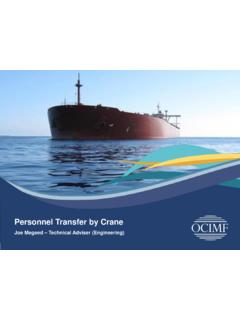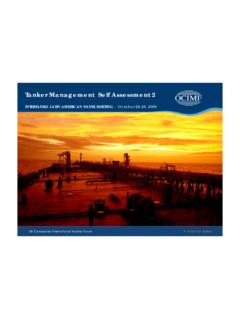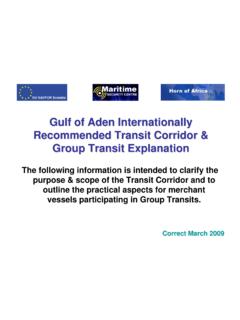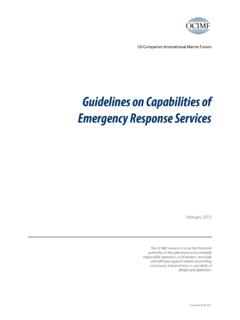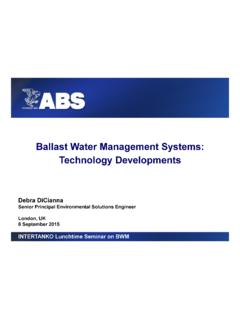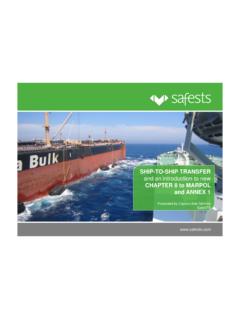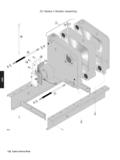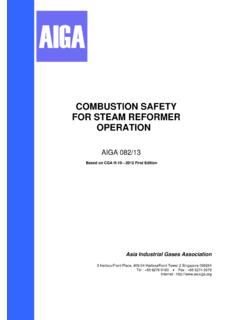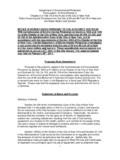Transcription of 3. ITEMS TO BE RECORDED - Intertanko
1 Intertanko A Guide for correct entries in the ORB (Part I - Machinery space operations) _____ _____ Page 6 3. ITEMS TO BE RECORDED Introductory notes The following pages of this section show a comprehensive list of ITEMS of machinery space operations which are to be RECORDED in the ORB, when appropriate, in accordance with regulation 20 of Annex I of MARPOL 73/78. The ITEMS have been grouped into operational sections, each of which is denoted by a letter code (A through I). These reference letters and numbers are used throughout the Guide. When making entries in the ORB, the date, the operational (letter) code and item number shall be inserted in the appropriate columns and the required particulars shall be RECORDED chronologically in the column record of operations . Each completed operation shall be signed for and dated by the officer(s) in charge. Each completed page shall be signed by the master of the ship.
2 The ORB contains many references to oil quantity. The limited accuracy of tank measurement devices, temperature variations and tank clingage will affect the accuracy of these readings. The entries in the ORB should be considered accordingly. Intertanko s observations and clarifications are RECORDED in italics throughout the Guide. List of ITEMS to be RECORDED , interpretations and clarification A. BALLASTING AND/OR CLEANING OF FUEL OIL TANKS 1. Identity of tank(s) ballasted and/or cleaned. 2. Whether cleaned since it last contained oil and, if not, type of oil previously carried. Date of last cleaning oil commercial name, density and/or viscosity 3. Cleaning process: .1 Position of ship and time at the start and completion of cleaning; .2 Identify tank(s) in which one or another method has been employed (rinsing through, steaming, cleaning with chemicals, type and quantity of chemicals used in m3).
3 3 Identity of tank(s) into which cleaning water was transferred. Quantity of cleaning water to be RECORDED as well. Intertanko A Guide for correct entries in the ORB (Part I - Machinery space operations) _____ _____ Page 7 4. Ballasting: .1 Position of ship and time at the start and completion of ballasting; .2 Quantity of ballast if tanks are not cleaned in m3; B. DISCHARGE OF DIRTY BALLAST OR CLEANING WATER FROM FUEL OIL TANKS REFERRED UNDER SECTION (A). 5. Identity of tank(s) discharged. 6. Position of ship at start of discharge. 7. Position of ship on completion of discharge. 8. Ship's speed(s) during discharge. 9. Method of discharge: .1 Through 15 ppm equipment; .2 To reception facilities. 10. Quantity discharged in m3. C. COLLECTION AND DISPOSAL OF OIL RESIDUES (SLUDGE) 11. Collection of oil residues. Quantities of oil residues (sludge and other oil residues) retained on board.
4 The quantity should be RECORDED weekly1 at the end of a voyage, but not more frequently than once a week. When ships are on short voyages, (This means that the quantity should be RECORDED once a week even if the voyage lasts more than one week)..1 Identity of tank(s) as per IOPP Supplement, Form B .2 Capacity of tank(s) in m3 cubic meters .3 Total quantity of retention in m3 cubic meters Anticipated daily quantity will be of HFO daily consumption plus % of DO daily consumption Anticipated daily quantity 15 lt / 1000 KW of actual ME Power for Diesel Engines only. Record used oils or other liquids of hydrocarbon origin, which due to degradation cannot be used any more. Entries must be done at the end of each voyage but not more frequently than once per week in case of short voyages. 1 Tanks listed in item of Form A and B of the supplement in the IOPP Certificate used for sludge.
5 Intertanko A Guide for correct entries in the ORB (Part I - Machinery space operations) _____ _____ Page 8 12. Methods of disposal of residue. State quantity of oil residues disposed of, the tank(s) emptied and the quantity of contents retained in m3: .1 To reception facilities (identify port); 2 .2 Transferred to another (other) tank(s) (indicate tank(s) and the total content in the tank(s)); .3 Incinerated (indicate total time of operation); .4 Other method (state which) D. NON-AUTOMATIC DISCHARGE OVERBOARD OR DISPOSAL OTHERWISE OF BILGE WATER WHICH HAS ACCUMULATED IN MACHINERY SPACES Bilge water is originating from leaking water seals of pumps, stern tube, leaking pipes/flanges of fuel oil, steam, sea water, fresh water, boiler water systems. The anticipated quantity depends on many factors (ER condition and maintenance, crew competence, age of vessel, etc.)
6 Guidance on daily bilge water quantity can be reported as: DR: should this line be in italics also? m for 40-3000 GRT m for 3000-5000 GRT m for 5000-7000 GRT 4 m for 7000-10000 GRT 6 m for above 10000 GRT For oil sealed stern tube these values should be reduced by 50% 13. Quantity discharged or disposed of in cubic metres 3. 14. Time of discharge or disposal (start and stop). 15. Method of discharge or disposal: .1 Through 15 ppm equipment (state position at start and end); .2 To reception facilities (identify port);2 .3 Transfer to slop tank or holding tank (indicate tank(s); state quantity transferred and the total quantity retained in tank(s) in m3). 2 Ships' masters should obtain from the operator of the reception facilities, which include barges and tank trucks, a receipt or certificate detailing the quantity of tank washings, dirty ballast, residues or oily mixtures transferred, together with the time and date of the transfer.
7 This receipt or certificate, if attached to the ORB part I, may aid the master of the ship in proving that his ship was not involved in a pollution incident. The receipt or certificate should be kept together with the ORB part I. 3 In case of discharge or disposal of bilge water from holding tank(s), state identity and capacity of holding tank(s) and quantity retained in holding tank. Intertanko A Guide for correct entries in the ORB (Part I - Machinery space operations) _____ _____ Page 9 E. AUTOMATIC DISCHARGE OVERBOARD OR DISPOSAL OTHERWISE OF BILGE WATER WHICH HAS ACCUMULATED IN MACHINERY SPACES This section refers to the bilge systems with floater switches in the bilge wells activating automatic bilge water transfer to the bilge water holding tank or with floater switches in the bilge water holding tank activating automatic bilge water discharge overboard-through the bilge water separator.
8 When these systems are used it could result in un-monitored discharge of the bilges. Bilges are normally emptied under D 15 through the 15 ppm equipment. 16. Time and position of the ship when the system was put into automatic mode of operation for discharge overboard through 15 ppm equipment. 17. Time when the system was put into automatic mode of operation for transfer of bilge water to holding tank (identify tank). 18. Time when the system was put into manual operation. 19. Method of discharge overboard .1 F. CONDITION OF THE OIL FILTERING EQUIPMENT DISCHARGE MONITORING AND CONTROL SYSTEM 19. Time of system failure 4 (and total quantity in tank). 20. Time when system was made operational. 21. Reasons for failure. G. ACCIDENTAL OR OTHER EXCEPTIONAL DISCHARGE OF OIL 22. Time of occurrence. 23. Place or position of the ship at the time of occurrence.
9 24. Approximate quantity and type of oil. 25. Circumstances of discharge or escape, the reasons therefore and general remarks. 4 The condition of the oil filtering equipment covers also the alarm and automatic stopping devices, if applicable Intertanko A Guide for correct entries in the ORB (Part I - Machinery space operations) _____ _____ Page 10 H. BUNKERING OF FUEL OR BULK LUBRICATING OIL 26. Bunkering: .1 Place of bunkering .2 Time of bunkering .3 Type and quantity of oil and identity of tank(s) (state quantity added, in tonnes and total content of tank(s)) .4 Type and quantity of lubricating oil and identity of tank(s) (state quantity added, in tonnes and total content of tank(s)) I. ADDITIONAL OPERATIONAL PROCEDURES AND GENERAL REMARKS Intertanko A Guide for correct entries in the ORB (Part I - Machinery space operations) _____ _____ Page 11 4.
10 FREQUENTLY FOUND FAILURES IOPP Certificate Supplement to IOPP certificate: Form A for ships other than oil tankers (see Appendix ) Form B for oil tankers (see Appendix ) (All numbers below refer to the above forms) Bilge separator throughput is stated in paragraph and should be verified with manufacturer s manual and type certificate Oil residue (sludge) tanks are covered in paragraph All tanks including incinerator sludge tank, HFO/DO/LO separators sludge tanks, stuffing box LO drain tank etc should be RECORDED . Bilge water holding tanks are covered in paragraph unless if a waiver of Reg 16 is valid (then ) Oil residues (sludge) incinerator capacity is stated in paragraph and should be verified with manufacturer s manual and type certificate For auxiliary boiler to burn Oil Residue (sludge) paragraph should be marked and this should be verified with burner s manual and piping system Sludge collection pumping incineration.
